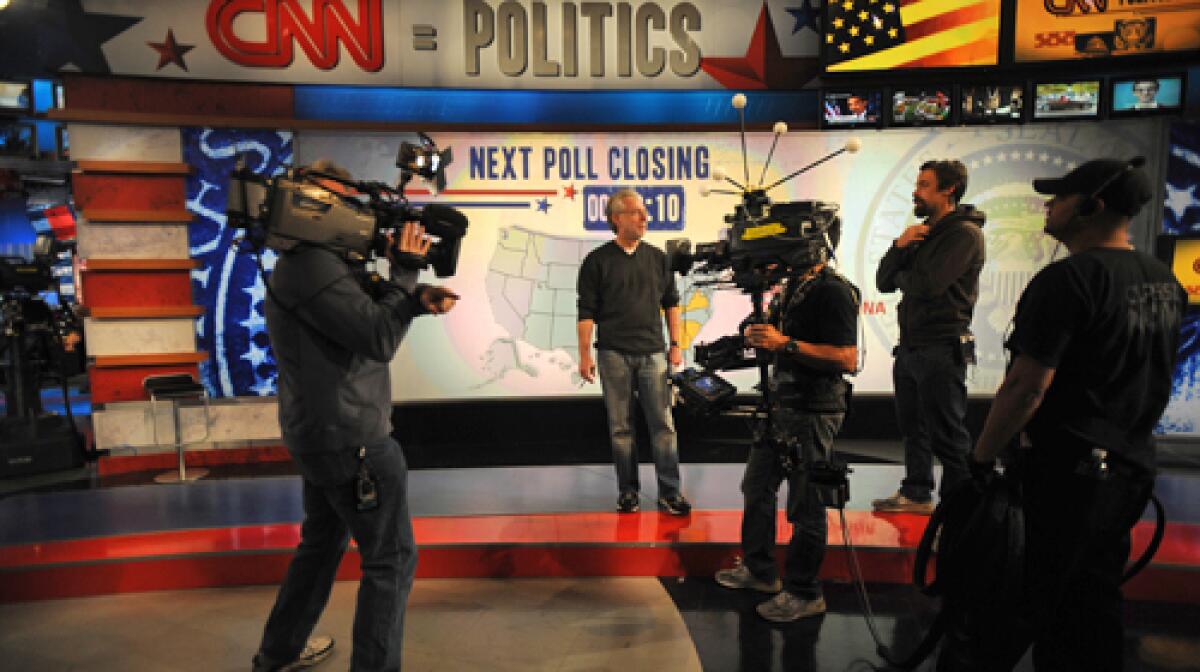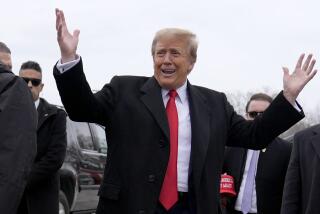TV news: Cautiously gung-ho

Reporting from New York -- CNN will use hologram technology to beam three-dimensional images of its field correspondents onto its Election Center set. NBC News will project a U.S. map on the Rockefeller Plaza ice skating rink, where the states will turn blue and red as the votes come in. ABC News will put the results up on three massive screens in Times Square.
Anticipating massive viewer interest, the broadcast and cable television networks are pulling out all the stops for Tuesday’s election, seeking to outdo one another with technological wizardry and scores of political analysts.
“We’ve just decided to go very big because you want the coverage to match the moment, and it’s been a historic campaign with unprecedented interest,” said David Chalian, ABC’s political director.
Election night will serve as a pivotal test of all the networks. This year’s political events have seen a shift in viewer loyalties, with cable news winning a larger share of the audience and challenging the traditional clout of ABC, CBS and NBC.
NBC still drew the biggest viewership during this summer’s political conventions, but it was nearly matched by both Fox News and CNN. And while audience for the three broadcast evening news programs has been flat so far this season, the cable news networks have enjoyed triple-digit ratings spikes.
On Tuesday, when all the networks will be running live coverage throughout the night, broadcast executives hope to prove they still have an edge.
“As long as we have the kind of time to do the in-depth reporting we’re capable of, generally the broadcast networks will outperform the cable networks,” said Rick Kaplan, executive producer of “CBS Evening News.”
But behind the elaborate preparations and gung-ho attitude, the television networks are heading into the night with a sense of cautious restraint -- especially when it comes to exit polls -- all too aware of the implications of a botched call.
“We don’t want ever a repeat of what happened in 2000,” said Phil Alongi, executive producer of NBC’s special events, referring to the networks’ haste in awarding Florida to Al Gore, then giving the state to George W. Bush before realizing it was too close to call.
“We learned so many lessons across the board,” he said. “One of the first: Get it right.”
To do so, the networks now follow strict rules that govern projections, examining not only exit poll data but actual vote tabulation and turnout information. NBC -- which keeps its decision desk isolated from the calls made by competing networks -- will only call a winner once its statisticians conclude that the chance of an error is less than 1 in 200. And no calls will be made until all the polls have closed in a state.
Extreme measures are taken to ensure that early data from the exit poll does not leak out, as it did in 2004, when the first wave of surveys showing John Kerry in the lead rocketed through cyberspace.
For much of the day, only a small group will have access to the exit poll, which is being conducted by Edison Media Research and Mitofsky International for the National Election Pool, a consortium of the networks and the Associated Press. Three members from each outlet will be sequestered in an undisclosed location in New York, where they will analyze the results of questionnaires filled out by 100,000 voters nationwide. Their cellphones and BlackBerries will be taken away until 5 p.m. ET, when they will be allowed to share the data with their newsrooms.
It’s the same procedure that was used in the 2006 midterm elections and effectively prevented the release of incomplete data, much to the relief of network executives.
“Exit poll information in the hands of trained professionals is perfectly fine,” said Sam Feist, CNN’s political director. “Exit poll information in the hand of the general public, who may not understand what it means or stands for, can be dangerous.”
That’s because exit polls are designed to provide a demographic portrait of voters, not to predict the winner of a close race. The early waves of data can be especially misleading because they do not necessarily reflect an accurate sample of the electorate.
This year, there’s another factor to take into account: the huge surge in early voting. To get a measurement of those voters, Edison/Mitofsky has been doing an extensive telephone survey in the last week, focusing on the 18 states with the highest concentration of absentee and early voting.
For all the precautions, the networks’ decision desks will still be analyzing the exit poll with some wariness. In both 2004 and 2006, the polls overstated the Democratic vote in many states. Because of that, Fox News stopped relying on the data halfway through election night in 2006, declaring it unreliable.
A similar problem cropped up during this year’s primaries, when exit polls often showed a greater lead for Sen. Barack Obama than the actual vote, decision desk directors said.
The reason is that “supporters who are more energized are more likely to fill out questionnaires,” explained Dan Merkle, ABC’s decision desk director.
About half of voters refuse to take the surveys. Edison/Mitofsky interviewers keep track of the demographic makeup of nonrespondents and use that information to adjust the final sample, said Joe Lenski, who directs the exit poll for the National Election Pool.
Network executives said they planned to be on guard for a possible lean in this year’s poll and would carefully compare the survey data from individual precincts with the actual vote in those places.
“Whereas 10 or 15 years ago the exit poll would have been used without question to project races, we’re going to be very, very cautious, and in many cases we’ll wait for raw data,” said Marty Ryan, Fox News’ executive producer of political coverage.
Other matters could complicate reporting the outcome, such as an expected swell in turnout and possible problems with voting machines. Both NBC and CNN have set up hotlines for voters to report problems at the polls.
Feist said the cable channel was prepared to field hundreds of thousands of calls, and had assembled a staff of 100 reporters, producers and attorneys to track complaints.
“There are always curveballs thrown on election night, and one thing that makes it so interesting is you never know where they’re going to come from,” he said. “All we can do is be ready to catch them.”
More to Read
The biggest entertainment stories
Get our big stories about Hollywood, film, television, music, arts, culture and more right in your inbox as soon as they publish.
You may occasionally receive promotional content from the Los Angeles Times.






